Generative AI, machine learning capabilities, and predictive analytics are gradually becoming part of modern applications. The finance and accounting industry is no exception: startups are emerging. They not only attract investment but also have real clients. One of them is Truewind — founded just around 2 years ago (at the time of writing). A core component of its offer for companies working in accounting is document classification, assigning categories, displaying a confidence score for classification accuracy, and explaining why a particular classification was applied. Integrating such a solution into a B2B SaaS product enables building a sustainable business model, gradually scaling and deepening automation in accounting processes. Truewind relies less on custom large language models, and its senior full-stack engineers build the application using the OpenAI API and vector databases.
What is Truewind?
Truewind is generative AI-based company based in San Francisco, raised a total funding of $17M over 2 rounds from 15 investors (Rho Capital, Thomson Reuters Ventures, Pathlight Ventures, Fin Capital, and Y Combinator). It has over 100 customers, including accounting firms like EisnerAmper and Frank Rimerman.
How Truewind Uses AI for Accounting?
Transaction Classification
Transaction classification (coding each transaction to the proper account, department, etc.) is a core bookkeeping step and a standard part of every accounting close process.
All financial records depend on correctly classifying transactions in the general ledger. This includes identifying the payee, determining the account category (expense vs asset), and matching payments to invoices.
Virtually 100% of accounting workflows involve transaction coding in some form. Every industry and company size (beyond perhaps the smallest cash-only operations) requires sorting of transactions into accounts. While the complexity may vary (a tech startup vs a manufacturing enterprise), the act of categorizing transactions (whether manually or via software rules) is universal in accounting.
Bookkeepers and accounting staff are the primary people performing this workflow.
Coding transactions is a repetitive, high-volume task that can consume a large portion of an accountant’s time. Accountants often spend hours identifying payees, choosing accounts, and adding tracking classes for thousands of transactions. Traditional accounting software offers limited automation, often requiring manual rule creation and constant oversight. This means the process is prone to errors (misclassified expenses) and drudgery, making it one of the more burdensome parts of bookkeeping. For transaction-heavy businesses, this pain is acute. In fact, automating even 90% of high-volume items (like credit card charges) saves substantial time and reduces errors, underscoring how much effort manual classification normally takes.
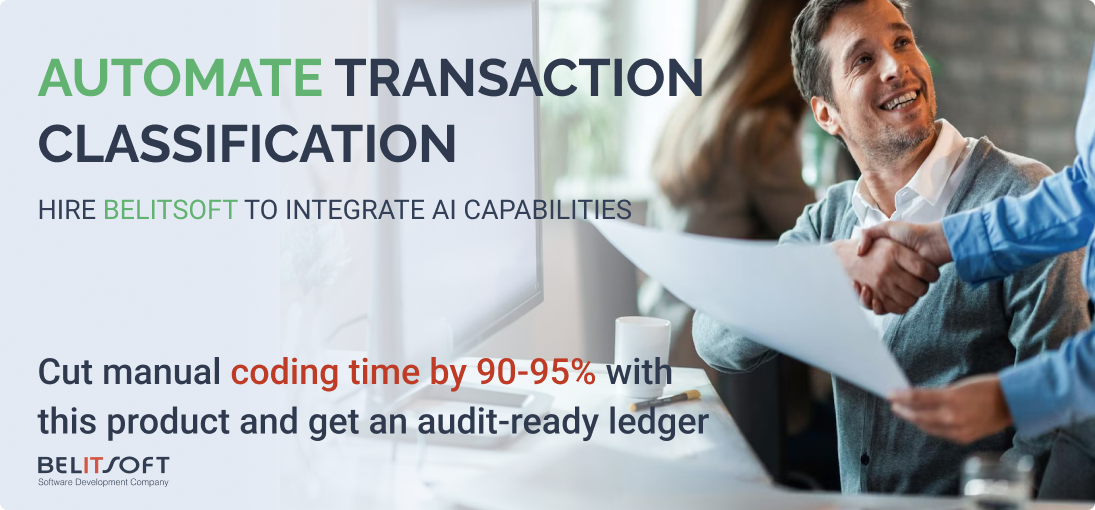
Truewind AI classifies each transaction before it is synced (posted) into the client’s accounting system.
It assigns the correct category (expense type or asset type), payee (vendor or merchant name), class (department, location, project), etc. Truewind also gives explanations and a confidence score, flags exceptions or low-confidence transactions for manual review, and allows bulk approval or review.
The accountant opens their dashboard and finds that most transactions are classified and posted, exceptions are neatly flagged with explanations, and the ledger is nearly closed. All they need to do is review a small handful of items and approve.
Transaction auto-classification using historical data is a classic LLM classification task. AI can achieve high accuracy (over 90%) in context-aware classification for this workflow.
The manual coding step takes up to 60–70% of the total time spent on the transaction classification workflow. After automation, this drops to 5–10%, leaving only the review of flagged items.
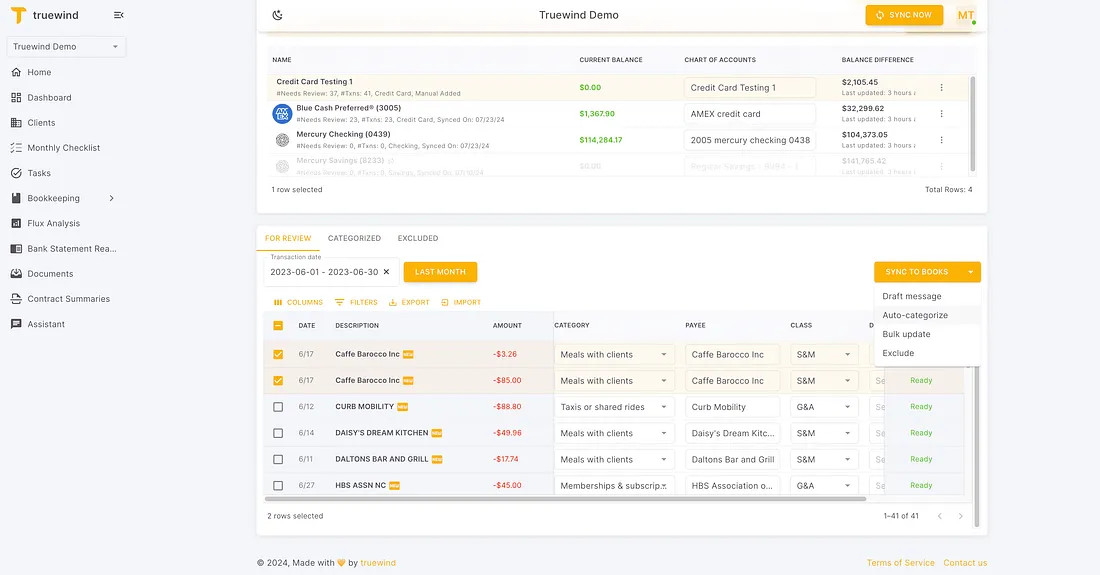 The AI classifies, flags exceptions, shows transactions in a structured format, and allows quick syncing to the ledger.
The AI classifies, flags exceptions, shows transactions in a structured format, and allows quick syncing to the ledger. The Truewind demo screenshot shows automated classification of bank and credit card transactions by category, payee, and class, with confidence indicators and review options before posting to the accounting system.
The Truewind demo screenshot shows automated classification of bank and credit card transactions by category, payee, and class, with confidence indicators and review options before posting to the accounting system.Accrual Automation
Accrual workpapers are a fundamental component of the month-end close in accrual accounting. They are used to record expenses and revenues in the correct period (prepaid expenses, accrued liabilities), ensuring compliance with GAAP/IFRS.
Any company using accrual basis accounting (virtually all beyond the very small cash-basis businesses) must prepare such workpapers each period, especially subscription-based businesses requiring precise monthly accruals.
Corporate accountants and controllers on accounting teams prepare and use accrual workpapers. This includes staff accountants compiling entries for accrued expenses or deferred revenue, and accounting managers or controllers reviewing them. Audit teams also examine these workpapers during financial audits, though the creation is done by the accounting department.
Maintaining accrual schedules manually is time-consuming and error-prone. Accountants often juggle disjointed Excel spreadsheets for items like prepaid expenses and fixed asset depreciation. It’s considered a tedious workload that adds to close deadlines.
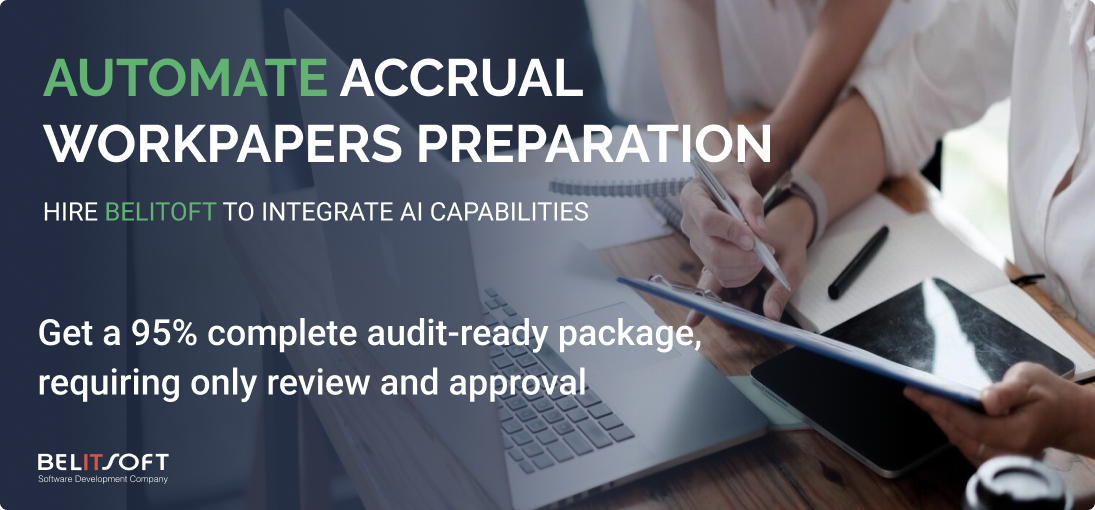
Truewind automates accrual workpapers. AI prepares a clean, structured, audit-ready accrual package that’s 95% done, where the accountant only needs to double-check flagged items and click "approve".
The system uses AI to read the transaction description and decide whether it's a prepaid expense that should be spread over future periods or a regular expense to book right away. This helps make accrual entries accurate and automatic.
Preparation of accrual workpapers takes up to 50% of the entire accrual workflow, but after automation, this time is reduced by up to 10 times. At the same time, the entire accrual workflow becomes approximately 30–40% faster.
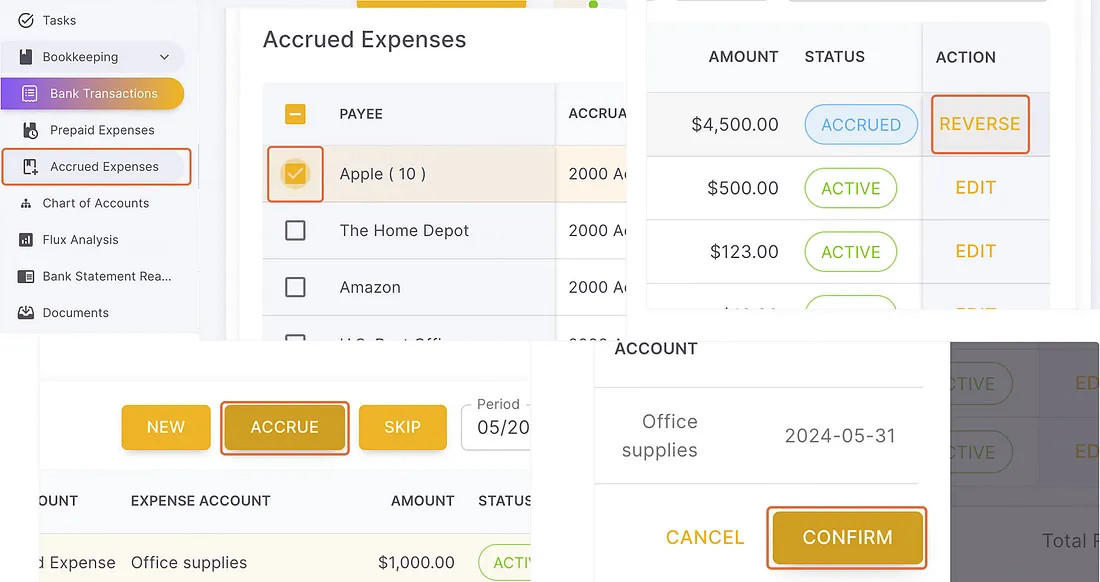 Truewind AI automatically suggests accrual entries based on historical data and transaction patterns. The accountant simply reviews, selects, and confirms entries.
Truewind AI automatically suggests accrual entries based on historical data and transaction patterns. The accountant simply reviews, selects, and confirms entries.AI Reconciliation Tool
Reconciliation is a cornerstone of accounting and financial reporting. Financial records (like the general ledger) should match with external statements or subledgers. Common examples are bank reconciliations (matching the books to bank statements) and intercompany or subledger reconciliations. This process is fundamental for verifying that all transactions are recorded completely and accurately. In practice, every period-end close includes multiple reconciliations to catch discrepancies.
Any organization that keeps books performs reconciliations regularly. Mid-size and large companies typically reconcile every bank account, credit card, and key balance sheet account each month. Even smaller companies perform at least bank and cash reconciliations.
Accountants and controllers are responsible for reconciliations. Staff accountants or accounting analysts usually do the detailed matching. For example, ticking and tying transactions in bank recs or reconciling subledger reports (AR, AP, inventory) to the general ledger. Accounting managers or controllers then review and sign off on these reconciliations. External auditors also heavily scrutinize reconciliations during audits to verify that balances are supported.
Reconciliation is a major bottleneck in the month-end close, often requiring hours or even days of manual work to match transactions line-by-line in Excel or other tools. High-volume accounts (such as cash or intercompany clearing accounts) make the process even more time-consuming, forcing teams to work late nights just to complete reconciliations. This error-prone, stressful “ticking and tying” process is a key reason why 82% of accountants view the close negatively, according to surveys.

Truewind is currently working on AI-powered matching and anomaly detection, but it’s not in production yet.
AI Contract Management Software
Contract management is about aligning financial records (revenue recognition, lease liabilities, etc.) with contract terms (start/end dates, payment terms, performance obligations, etc.). For example, under revenue recognition standards (ASC 606 / IFRS 15), accountants must identify all key contract terms to allocate and time the revenue properly.
This workflow is essential for software, telecom, construction, leasing, and other industries. Many large companies have material contracts (SaaS subscriptions, multi-year sales agreements, vendor contracts, leases), so they require this process.
Often a technical accounting or revenue recognition team reviews customer contracts to determine how to record revenue or expenses. They coordinate with legal or sales operations to obtain contract details. Auditors also pay close attention to contract accounting (for example, checking that revenue is recognized according to the contract terms).
Extracting key data from contracts is typically manual: accountants must read lengthy agreements and enter key details into spreadsheets or an ERP.
AI streamlines contract management by employing optical character recognition (OCR) and natural language processing to automatically extract key terms from complex sales contracts. For example, the system pulls out payment schedules, renewal dates, deliverables, cancellation clauses, and other critical data directly from the contract documents. Rather than an accountant manually poring over each PDF, AI scans the text and populates those details into the accounting system or workpapers.
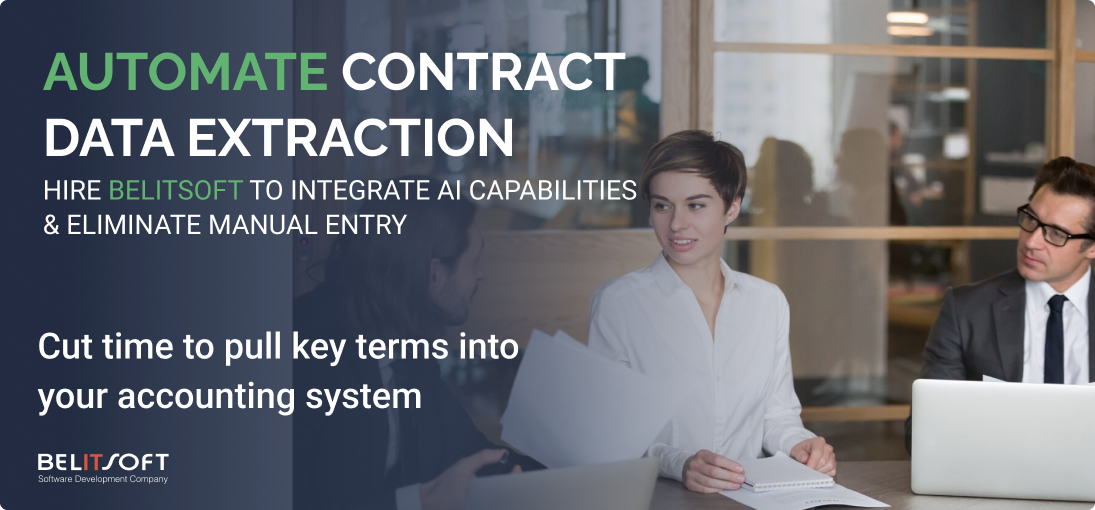
Complex Contracts
Complex contract management is an extension of contract management for businesses with highly customized or multi-element contracts. It covers scenarios like contracts with multiple performance obligations, custom pricing & billing terms, contract amendments, and revenue that must be recognized over time or under various conditions. Managing these manually is difficult, as revenue often needs to be broken into multiple components over time.
For example, a SaaS company with custom contracts splits a contract into software license revenue, service revenue, and subscription revenue over different periods.
Enterprise software companies, telecommunications, defense contractors, or any industry offering configurable bundles and multi-year deals have complex contracts.
Complex contracts are one of the most challenging areas of accounting. Many ERPs don’t fully support intricate arrangements out of the box, so companies resort to manual processes or expensive add-on systems. The workload involves reading through unique contract terms, manually configuring billing or revenue schedules, and constantly updating them for contract changes (amendments, renewals).
AI platform ingests a complex contract and then automatically generates the necessary sales orders or accounting entries directly in the ERP. For example, if a contract has multiple components (subscription fee, one-time setup fee, future rate increases, etc.), the system parses those details and creates accurate billing schedules.
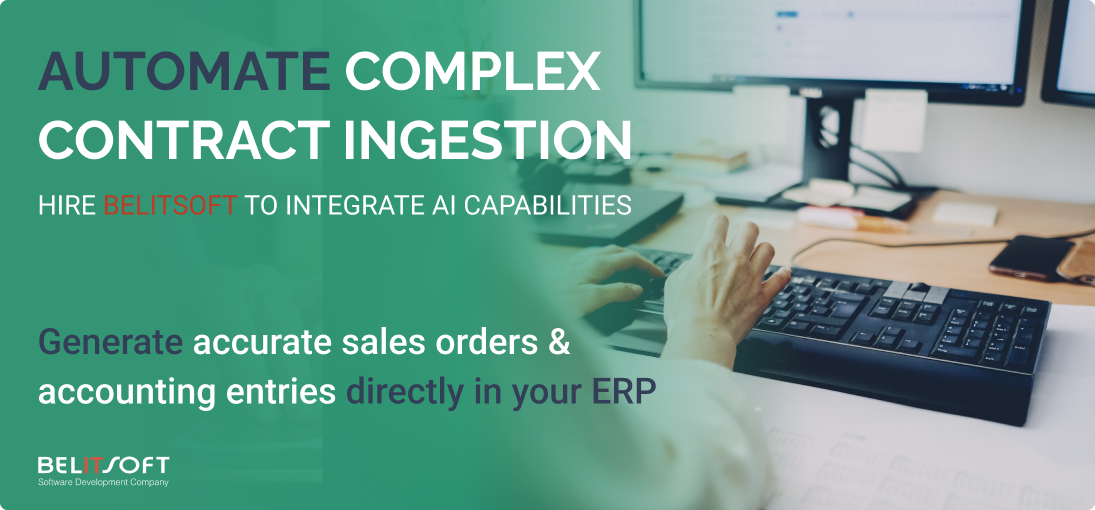
Truewind is currently working on AI-powered contract management, but it’s not in production yet.
AI automates complex processes and improves decisions in finance and accounting industries. If you're looking to build an AI system, our guide on AI classification model costs breaks down key factors that influence development budgets and strategic AI investments. For a real-world example, see how BloombergGPT leverages AI for financial document classification, sentiment analysis, and more.
Automation of Flux Analysis in Accounting
Flux analysis (fluctuation analysis) is a common process during financial close and review. It compares account balances or financial line items between periods (month-over-month or year-over-year, or against budget) and analyses significant variances. In many organizations, flux analysis is part of internal controls or audit preparation, as management and auditors ask, “Why did this number change so much from last period?” Therefore, it’s a standard analytical step in the accounting/FP&A workflow for medium and large companies.
Public companies, for example, must explain period-to-period changes in financial statements (Management Discussion & Analysis), so flux analysis is mandatory for them.
Flux analysis is used by those who need insight into financial changes: corporate accounting teams produce the analysis, and CFOs, controllers, audit committees, and auditors consume the results.
Flux analysis can be quite tedious and is often cited as a pain point, especially because it’s traditionally done with a lot of manual work in spreadsheets. Accountants export trial balances to Excel, compute variances, and then manually write explanations or investigate transaction details for the differences. This process is time-consuming, and it becomes frustrating when late adjustments require re-doing the analysis.

Truewind is currently working on automating flux analysis by using advanced algorithms and AI, but it’s not in production yet.
Pro-forma Forecasting
Pro-forma and forecasting tools are used to create projected or “as if” financial statements (for example, forecasting the next quarter’s income statement, or combining entities for a what-if scenario). While not part of the ledger bookkeeping itself, they rely on accounting data and are often maintained by finance teams in conjunction with accounting. Many accounting departments (especially in firms that offer client advisory or in family office contexts) include forecasting as a service to provide insight to management.
Nearly all public companies and many mid-size to large firms use these tools for budgeting, cash flow forecasting, and strategic planning, such as annual budgets and fundraising. In accounting firms, offering projections and advisory is a value-add, especially for larger clients. So while not a required step for compliance, in practice, most companies perform this workflow to guide decision-making.
In a corporate setting, the FP&A (Financial Planning & Analysis) department typically takes actual accounting data and projects it forward, and these are the primary users of forecasting software.
Financial forecasting and pro-forma budgeting are quite challenging. The pain comes from dealing with uncertain variables, large data sets, and the limitations of manual tools. Many teams still use spreadsheets for budgeting. According to a CFO study, 56% of finance leaders said the growing complexity of forecasting and budgeting is their greatest internal challenge.
Common pain points include: consolidating data from multiple sources, updating forecasts for actual results, and running multiple scenarios without a good system. If done manually, producing a rolling forecast or pro-forma statements can consume a lot of time and still yield inaccurate results, making it a notable pain area in finance.

Truewind is currently working on a cash flow projection feature that uses real-time data from the books to predict future cash positions. The system employs predictive analytics and machine learning to analyze historical cash patterns, upcoming payables/receivables, and other inputs, and then produces a forecast. However, it’s not in production yet.
Intercompany Reconciliation Automation
For companies with multiple legal entities, managing intercompany transactions is a critical part of the accounting and consolidation workflow. These financial dealings between subsidiaries or business units under the same parent, such as sales of goods from one subsidiary to another, or shared expenses must be recorded in each entity’s books and then eliminated or adjusted upon consolidation so that they don’t inflate the group’s overall financials. Intercompany accounting also involves transfer pricing adjustments, foreign exchange for cross-border intercompany, and reconciliation of intercompany balances. It’s considered one of the most complex routine tasks in finance because of the volume and need for precision.
For any sizable or global company with subsidiaries, this process is absolutely required.
In fact, many large enterprises have dozens or hundreds of entities and thus heavy intercompany activity (e.g. cross-charges, intercompany sales, loans between entities). In those environments, intercompany accounting is unavoidable and happens every month. Nearly all multinational corporations must deal with it (often at a large scale, since intercompany entries are multiples of external transactions in volume).
Accounting teams at multinational or multi-entity companies, including consolidation accountants, corporate controllers, and treasury or tax specialists, use this workflow. The process starts with local entity accountants recording intercompany invoices or transfers, but the critical part is handled by corporate accounting during consolidation (to reconcile and eliminate those intercompany balances). Sometimes a company has a dedicated “Intercompany Accountant” or a team focused on intercompany reconciliations. The tax department also gets involved because transfer pricing (pricing of intercompany sales) has tax implications.
Intercompany accounting is widely recognized as a headache for finance teams. Surveys have found that 96% of finance stakeholders report challenges with intercompany processes, and an astounding 90% said their staff pull all-nighters at least once a year solely due to intercompany issues. The pain comes from difficulties in matching transactions between entities (discrepancies in timing or amounts), dealing with different currencies and exchange rates, and ensuring all parties record the transactions consistently. Overdue intercompany reconciliations can linger for years, causing uncertainty and even risk of audit issues. Nearly half of companies report that unresolved intercompany imbalances create business uncertainty and risk of compliance problems.

AI and intelligent rules automatically identify intercompany pairs. For example, if one entity records an intercompany sale, it finds the corresponding purchase in the other entity. During consolidation, AI automatically eliminates those intercompany entries so they won’t double count in the consolidated financials. This ensures compliance with accounting standards (GAAP/IFRS requires that intercompany revenue/expenses be removed) and saves a huge amount of manual work. The system also manages currency conversion and exchange rate adjustments in real-time, which is a big part of intercompany for global companies.
Truewind is currently working on intercompany reconciliation automation with AI, but it’s not in production yet.
How Belitsoft Can Help
Belitsoft offers standout software engineers to build AI and machine learning applications, as well as data-intensive distributed systems for finance and accounting. We also provide exceptional full-stack engineering services to architect and develop software products that use AI technology to reimagine traditional bookkeeping and finance processes.
Our developers create web applications and LLM applications using both custom LLMs and the OpenAI API integrated with vector databases. They also build and manage the technical infrastructure supporting databases, servers, and APIs.
Partner with Belitsoft and automate your accounting workflows with Generative AI. By outsourcing our software developers, you eliminate manual entry, receive audit-ready outputs and generate accrual workpapers, financial statements, and variance reports in minutes ready for an accountant’s review to flag items, not rebuild them. Contact us to discuss your project.
Rate this article
Recommended posts
Our Clients' Feedback


















.jpg)
.jpg)
.jpg)
.jpg)
.jpg)
.jpg)
.jpg)
.jpg)
.jpg)
.jpg)
.jpg)
.jpg)
.jpg)
.jpg)
.jpg)
.jpg)
.jpg)
.jpg)
.jpg)
![Artificial Intelligence in Education [Ultimate Knowledge Hub]](/uploads/images/blog/posts/previews/image_163177848252-image(600x250-crop).jpg)
.jpg)
.jpg)
.jpg)
.jpg)
.jpg)
.jpg)
.png)
.jpg)
.jpg)
.jpg)
.jpg)
.jpg)
.jpg)
.png)
















We have been working for over 10 years and they have become our long-term technology partner. Any software development, programming, or design needs we have had, Belitsoft company has always been able to handle this for us.
Founder from ZensAI (Microsoft)/ formerly Elearningforce